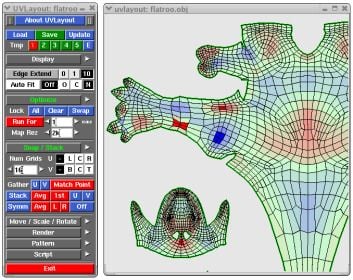

Total frames (10 for Animation of 20 frames) : 200 frames For example, in blender, you should have: For an animated Object (or multi object): Use LoadObjectwithchildren ().
#Export models with 2 uv channels from ultimate unwrap 3d skin#
x : export meshes, normals, uv coordinnates, export skin weights, amatures bones, rest position, animation, animation as animations. dae : Apply modifiers, selection only, triangulate. obj : Apply Modifiers, Include Edges, Include Normals, Include UV, Objects objects as OBJ Menu file / export: animation, choose Collada (dae) or. Select the 3d model and the skeleton, if an animated object. Check that the 3d model and skeleton are at the center of the view. Select all the keys and press x, select "clean channels". You can clean some channels in the dopesheet screen. When your animation is complete, you will be able to export. Pay attention to check the "only channel available", never insert scale. You can choose to insert for LocRot channels only. It is possible to activate the autokey. Then animate your model by moving the bones or doing rotations, never scale! Moving a bone and press the i button to insert a key, choose LocRot.

Warning: use only one action for all your animations as blender exports only the first action (export in. Open dopesheet screen, to access the animation keys if necessary. Select the 3d model, and enter weight paint mode and select each vertex group, and then change the weight in the left panel (t key). If necessary, change the weight painting to make everything okay. To parent the 3d model with skeleton, select the 3D model and the skeleton then press ctrl + p, choose automatic weight if possible, or use envelope. Once in place, before to parent the 3d model with skeleton, apply scale for the armature (and even rotation if necessary). It seems we can not use inverse kinematics (IK solver) or other modifiers of bones, otherwise it fits the scale of the frame. To enlarge a bone, do not use the scale, but pull the head of the bone, for example. It is unfortunately not possible to use rigify because of scales on it. Create the skeleton, creating the bones by hand. Because when exporting, this will be the pivot of the object. Put your model in the center of the view, ditto for the skeleton. If not, then you should apply the scale with ctrl + a / apply scale. Scale the model in edit mode and not in object mode. before creating the skeleton/armature, check out the size of your model, if necessary, export in. Otherwise, you may need to convert the model with a 3D conversion tool like Ultimate unwrapp 3d (about 60 €) or open3dmodel (free and open source). So be especially careful never to use them in blender. If your object is not animated, go directly to 3) export the model Create texture : you can paint on the model, including pictures, or use the tool 'bake' in the render panel at the bottom. Result of the uvmapping (here, some face are overlapped) If necessary, edit the uv mapping, to avoid having faces that overlap. Unfold uv: in edit mode, panel tool / uv tools, use unwrapp. clic on your object 3D, and use the Tab key to enter in editmode or use this menu :

to edit your object3D, reduce the number of faces. Do not have too many faces (for a character between 5 approximately), if necessary, reduce the number of faces. (My orginal post (from my blog) can be translated in lots of langage ) :ġ) create or import 3D object in the blender. Note : other screenshots will be added soon Here is a tutorial to export a 3D object or animation from blender to agk.


 0 kommentar(er)
0 kommentar(er)
